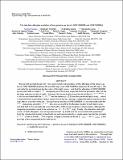Por favor, use este identificador para citar o enlazar a este item:
http://hdl.handle.net/10261/212621COMPARTIR / EXPORTAR:
 SHARE SHARE
 CORE
BASE CORE
BASE
|
|
| Visualizar otros formatos: MARC | Dublin Core | RDF | ORE | MODS | METS | DIDL | DATACITE | |

| Título: | The Late-time Afterglow Evolution of Long Gamma-Ray Bursts GRB 160625B and GRB 160509A |
Autor: | Kangas, Tuomas; Fruchter, Andrew S.; Cenko, S. Bradley; Corsi, Alessandra; Ugarte Postigo, Antonio de CSIC ORCID; Pe'er, Asaf; Vogel, Stuart N.; Cucchiara, Antonino; Gompertz, Benjamin; Graham, John; Levan, Andrew; Misra, Kuntal; Perley, Daniel A.; Racusin, Judith L.; Tanvir, Nial | Palabras clave: | Gamma ray bursts Relativistic jets |
Fecha de publicación: | 2020 | Editor: | IOP Publishing | Citación: | Astrophysical Journal 894(1): 43 (2020) | Resumen: | We present post-jet-break Hubble Space Telescope, Very Large Array, and Chandra observations of the afterglow of the long gamma-ray bursts GRB 160625B (between 69 and 209 days) and GRB 160509A (between 35 and 80 days). We calculate the post-jet-break decline rates of the light curves and find the afterglow of GRB 160625B is inconsistent with a simple t(-3/4) steepening over the break, expected from the geometric effect of the jet edge entering our line of sight. However, the favored optical post-break decline is also inconsistent with the f(nu) proportional to t(-p) decline (where p 2.3 from the pre-break light curve), which is expected from exponential lateral expansion of the jet; perhaps suggesting lateral expansion that only affects a fraction of the jet. The post-break decline of GRB 160509A is consistent with both the t(-3/4) steepening and with f(nu) proportional to t(-p). We also use boxfit to fit afterglow models to both light curves and find both to be energetically consistent with a millisecond magnetar central engine, but the magnetar parameters need to be extreme (i.e., E similar to 3 x 10(52) erg). Finally, the late-time radio light curves of both afterglows are not reproduced well by boxfit and are inconsistent with predictions from the standard jet model; instead, both are well represented by a single power-law decline (roughly f(nu) proportional to t(-1)) with no breaks. This requires a highly chromatic jet break and possibly a two-component jet for both bursts.© 2020. The American Astronomical Society. All rights reserved. | Versión del editor: | http://dx.doi.org/10.3847/1538-4357/ab8799 | URI: | http://hdl.handle.net/10261/212621 | DOI: | 10.3847/1538-4357/ab8799 | ISSN: | 0004-637X |
| Aparece en las colecciones: | (IAA) Artículos |
Ficheros en este ítem:
| Fichero | Descripción | Tamaño | Formato | |
|---|---|---|---|---|
| IAA_2020_ApJ_The_late_time_afterglow.pdf | 561,84 kB | Adobe PDF |  Visualizar/Abrir |
CORE Recommender
SCOPUSTM
Citations
16
checked on 17-abr-2024
WEB OF SCIENCETM
Citations
16
checked on 27-feb-2024
Page view(s)
139
checked on 23-abr-2024
Download(s)
83
checked on 23-abr-2024
Google ScholarTM
Check
Altmetric
Altmetric
NOTA: Los ítems de Digital.CSIC están protegidos por copyright, con todos los derechos reservados, a menos que se indique lo contrario.
